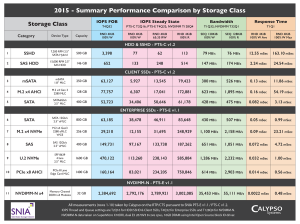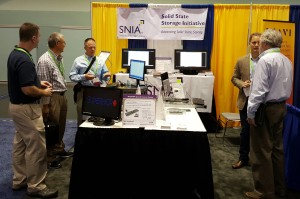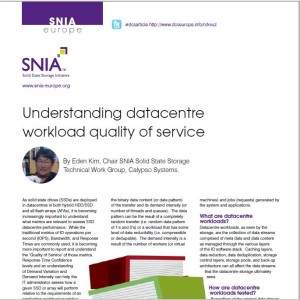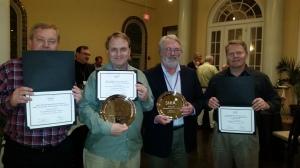A classic case of SNIA Solid State Storage Initiative (SSSI) member collaboration for industry advancement was on display in the SSSI booth for NVDIMM-N demonstration at the Flash Memory Summit (FMS) 2015. Under the direction of SSSI Chair Jim Ryan and coordinated by NVDIMM SIG co chairs Arthur Sainio and Jeff Chang and TechDev Committee chair Eden Kim, the SSSI was able to update and include NVDIMM-N storage performance in the SSSI marketing collaterals on the Summary Performance Comparison by Storage Class charts.

Five SSSI member companies – AgigA Tech, Calypso, Micron, SMART Modular, and Viking Technology – collaborated over a four week period on the introduction of a new NVDIMM-N storage performance demonstration. While it is rare to have potential competitors collaborate in such a fashion, NVDIMM-N storage represents a new paradigm for super fast, low latency, high IO/watt storage solutions. The NVDIMM-SIG has taken a leadership position by evangelizing the technology and developing the industry infrastructure necessary for large scale deployment.
This collaboration highlighted a classic blend of technical, marketing and industry association cooperation.
In the weeks leading up to FMS, the NVDIMM-SIG planned for an in-booth demonstration of the NVDIMM-N storage modules. To pave the way for universal adoption, the team worked together to dial in the Intel Open Source block IO development driver to meet the standards of the SNIA Performance Test Specification (PTS). An added goal was inclusion of NVDIMM-N modules as a new line item on the Summary Performance Comparison by Storage Class chart which lists PTS performance for various storage technologies. Under the guidance of NVDIMM-SIG, a rush project was instigated to get NVDIMM-N performance data tested to the PTS for the trade show.
Micron took the lead by lending a Supermicro server with Micron NVDIMM-N to Calypso for testing. Calypso then installed CTS test software on the server to allow full testing to the PTS. Viking and SMART Modular contributed by helping dial in the drivers, as well as sending modules from Viking and SMART Modular to cross reference with the Micron modules. The test plan was comprised of several test iterations using single, dual and finally quad modules using each of the vendor contributed modules.
The early single and dual module tests ran into repeatability and stability issues. NVDIMM-SIG consulted with Intel on the nuance of the Intel block IO driver while Calypso continued testing. The team successfully completed a test run that met the PTS steady state requirements on the quad module in time to release data for the show.
We had a solid demonstration at the SNIA SSSI Flash Memory Summit Booth on NVDIMM-N Performance complete with marketing collateral available for review and a handout. NVDIMM-SIG members responded to the many questions and interest in the NVDIMM-N storage technology.

“Once again,” said SSSI Chair Jim Ryan, “we can see the value and benefit of SNIA SSSI to its members, the SNIA educational community and the NVDIMM industry. I believe this is a great case study in how we all can contribute and benefit from working within the SSSI for the betterment of individual companies, market development and the Solid State Storage industry at large.” SSSI provides educational and marketing materials free of charge on its public website while SNIA SSSI members may join the NVDIMM-SIG and other SSSI committees. Anyone interested to find out more about the SSSI or any of its many committees can go to the following link http://www.snia.org/sssi.
 Eden Kim, Chair of the SNIA Solid State Storage Technical Working Group, has recently authored an article on Understanding Data Center Workloads. In it, he defines workloads and specifically data center workloads, describes how they are tested, and shows how to measure workloads for performance analysis. Industry standard test methodologies that ensure fair and accurate testing of SSDs both at the device and system level are described, along with how to use them on a reference test platform, Eden also describes in depth Response Time Confidence levels and how an understanding of Demand Variation and Demand Intensity can help the IT administrator assess how a given SSD or array will perform relative to the requirements of an application workload or relative to a specific Response Time Ceiling thus helping in the overall system optimization, design, and deployment.
Eden Kim, Chair of the SNIA Solid State Storage Technical Working Group, has recently authored an article on Understanding Data Center Workloads. In it, he defines workloads and specifically data center workloads, describes how they are tested, and shows how to measure workloads for performance analysis. Industry standard test methodologies that ensure fair and accurate testing of SSDs both at the device and system level are described, along with how to use them on a reference test platform, Eden also describes in depth Response Time Confidence levels and how an understanding of Demand Variation and Demand Intensity can help the IT administrator assess how a given SSD or array will perform relative to the requirements of an application workload or relative to a specific Response Time Ceiling thus helping in the overall system optimization, design, and deployment.



